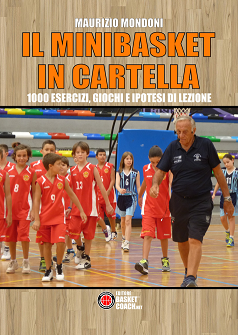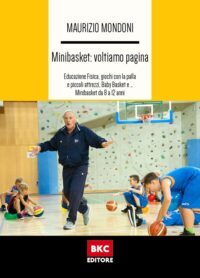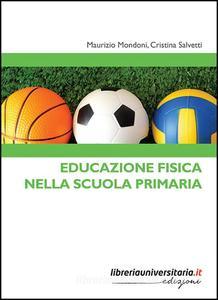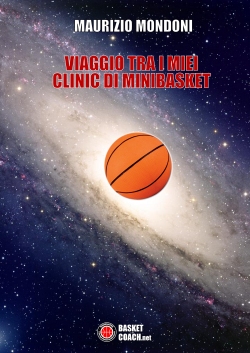Drills for Minibasketball fundamentals
Drills for Minibasketball fundamentals
Dribbling
1) Dribbling standing still, on the move, around the court, following the perimeter of the court, in the middle of the court.
2) Dribble in the middle of the court responding to different signals (voice, whistle, tambourine, hand clap), change speed, direction, reverse walking, change hands.
3) Dribble in the court following a previously prepared path.
4) Dribble with two balls, in place and on the move.
5) “Statue game”: the children dribble in the middle of the court (one ball each) and at the signal from the Instructor they must stop (in one time or in two time).
6) “Playing catch”: the children (one ball each) dribble in the court trying not to be touched by the child who is “It”. The child who is touched becomes “It” in turn. In this way the children learn to change hands, reverse walk, change direction, speed while “playing” to reach an objective.
7) The same game, with the difference that the child who is “It” must try to touch as many children as possible in a set period of time.
8) The children dribble following the lines of the court, and when they meet another child they must change hand, reverse, change direction.
9) “The Jack-Hammer game”: all of the children dribble in the court, imitating a jack-hammer (dribbling high, low, slowly, fast).
10) “The car game”: all the children (oe ball each) are scattered throughout the court an imitate an automobile. In basic position when the car is still, dribbling when the motor is turned on, starting the dribble when the car starts, dribbling throughout the court (forwards, backwards, right and left) as the car moves, stop dribbling when the car stops at the streetlights (the Instructor shouts “red light”, start dribbling again moving forward (when the Instructor says “green light”), returning to the starting point (jump stop).
11) “The tail game” one child without a tail (handkerchief) dribbles throughout the court and for a certain period of time tries to grab the tails of the other children who run away dribbling in the court. The child who manages to grab the most tails wins.
12) Free dribbling throughout the court and at the signal stop and turn towards a basket, the side-lines, the end-lines (depending on the instructions of the Instructor).
13) “Self-passing”, stop and start dribbling (in all direction).
14) “Dog and hare game”: divide the children into two teams (ore ball each), giving each child (dog) a child to touch (hare). The dogs stand in the central circle and the hares in the middle of the court. When the Instructor gives to go, the dogs dribble and must try to touch the hares. Those who are tagged must stop and sit. The child who manages in a set period of time to touch the most hares is the winner.
15) “The fisherman game”: all of the children (fish) stand in a line behind the end line (one ball each), while one child is a half court (fisherman). At the signal from the Instructor, the children must dribble and try to reach the other end line of the court without letting the fisherman touch them. Those who are touched become fisherman. At the beginning of the game, it is not important to pay too much attention to the violation. Playing will teach speed, anticipation and choice of dribbling.
16) “Run and chase game”: the children are divided in two teams (one ball each) and are lined up at half court (ore team faces one basket and the other faces the other basket, they stay back to back. Each team is given a number (“one” or “two”), a color (“black” or “white”). Every time that the Instructor call a number, or a color, the team which is called starts dribbling towards the end line and the other team, after turning, starts to dribble and tries to touch those who are running away (each child can only touch the child who was back to back with him or her). Those who reach the end line are safe, while those who are touched must raise their hand (no one eliminated). The team which manages to touch the most children in a set period of time wins. The game may be played starting from a standing position, kneeling, down, sitting, lying on the back or tummy.
17) “The four corners game”: the children from a square (one ball each) and one child in the middle tries to occupy a free corner. At the signal the children at the corner must change place while dribbling and the child who is “It” must try to occupy a place. The child who remains without a place becomes “It” and the game begins again. It is important to establish the direction of movement (clockwise-counterclockwise or free) at the beginning of the game.
18) “Free tag game”: the children (one ball each) run dribbling around the court and one child (“It”) tries to touch them. The children who are touched stop and stretch out an arm, waiting to be touched and freed by the other children.
19) “Game 1-2-3 star”: the children (one ball each) stand in a line behind the end line and one stands at half court (with the ball). The child at half court (with his or her back to the other children), after shouting “1-2-3-star”, turns around and tries to guess which children have not stopped dribbling (the children start dribbling when the child at half court begins to shout “1-2-3 star”). Those who are seen to move return to the starting position (they nay continue to play). The first to reach half court without being seen by the child who is at half court is the winner of this game.
20) “Relay dribbling races”: there are many types of relays (forwards, forward and backwards) without the ball (running, jumping), or dribbling, with one ball each ore one per team. At a signal given by the Instructor, the first of the line starts and follows the path (slalom, running, around markers). The child then returns, stops in front of the second line, touches the ball and the game continues. The team which arrives first after having completed the path ids the winner.
21) “Relay race with pins”: divide the children into two teams (one ball each) near the end line. At the signal, the first child of each line start and dribble with one hand while with the other must try to knock down the pins along the path, and then come back dribbling quickly to let the second in line start. The second starts and while dribbling with one hand must try to stand the pins up again (the game cannot continue if the pins are not standing) and so on. The team which arrives first is the winner.
22) Dribble freely in the court and change hand, reverse walk, change direction, speed, turn around dribbling.
23) Dribble following the perimeter of the court and change direction, speed, hand, as indicated by the Instructor.
24) Dribble in the court and exchange ball with the other children while continuing to dribble (do not interrupt the dribbling).
25) Place the children in group of three, four or five along the end line and set the marker in the court at the two free throw lines and at half court. At the signal given by the Instructor, the first in line starts. At every marker they will do the following:
– change hand (in front, behind the back and between the legs);
– reverse;
– change speed;
– pivot dribble;
– jump stop;
– reverse, change hand and dribble forward;
– change direction.
26) Teach dribbling drills: start, dribble and stop, with change of hand, reverse, change of direction, pivot, ball protection, behind the back, faking pivot and pivot, with esitation.
—————————————
ALTRI ARTICOLI GIA’ TRATTATI SUL BLOG NELLE CATEGORIE. CLICCA SULLE CATEGORIE PER LEGGERLI.
TECNICA
ESERCIZI
COMUNICAZIONE
SCUOLA E MINIBASKET
MINIBASKET NEL MONDO
PEDAGOGIA
FISIOLOGIA
VIDEO
SCARICA GRATIS LA MIA DISPENSA L’ALLEDUCATORE
Vi ricordo che potete iscrivervi alla mia newsletter gratuita, per restare sempre aggiornati sul #minibasket a misura di bambino. In regalo la dispensa l’Alleducatore.
Prof. Maurizio Mondoni
#iostoconibambini
#alleducatore
#minibasket




